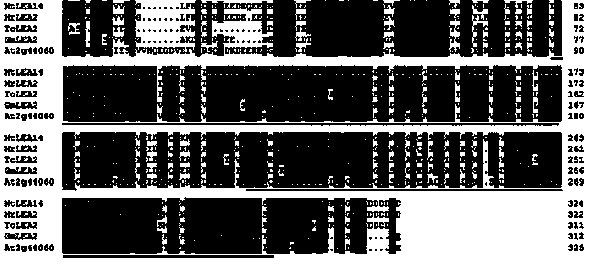Medicago ruthenica late-embryogensis abundant protein gene and application thereof
An embryogenesis, lentil bean technology, applied in the application, genetic engineering, plant genetic improvement and other directions, can solve the problems of gene cloning and stress resistance function identification without the late embryonic rich protein of lentil bean, and achieve the improvement of salt resistance. Effect
- Summary
- Abstract
- Description
- Claims
- Application Information
AI Technical Summary
Problems solved by technology
Method used
Image
Examples
Embodiment 1
[0033] Example 1 The late embryogenesis rich protein gene of lentil, the gene encoding MrLEA2, is derived from lentil, and it has the nucleotide sequence shown in SEQ ID NO.1 from position 1 to position 1181 in the sequence table.
[0034] 1. Cloning of MrLEA2 gene, a protein rich in late embryogenesis of lentil.
[0035] 1. Low temperature stress treatment and transcriptome sequencing of lentil seedlings:
[0036] ⑴Lentulina faecalis low temperature stress treatment:
[0037] After the lentil seeds were treated with concentrated sulfuric acid for 10 minutes, they were washed with tap water to remove residual sulfuric acid. The treated seeds are placed in a petri dish with double filter paper and germinated under the conditions of 21℃ and 16h / 8h photoperiod; 14 days later, the seedlings are transplanted into vermiculite to continue cultivation under the above conditions. Water once with 1 / 2MS nutrient solution; after 14 days, transfer the seedlings to a -4℃ light culture incubator f...
Embodiment 2
[0114] Example 2 Enriched protein gene in late embryogenesis of lentilus. This gene is the MrLEA2 coding gene. It has the formation of one or more base deletions, insertions or substitutions in SEQ ID NO.1 from position 1 to 1181 in the sequence table. Functionally active alleles.
[0115] The cloning of the late embryogenesis-rich protein MrLEA2 gene of lentil is the same as the prokaryotic expression of the late embryogenesis-rich protein MrLEA2 gene of lentil Example 1 .
Embodiment 3
[0116] Example 3 Enriched protein gene in late embryogenesis of lentil, this gene is MrLEA2 coding gene, it has figure 2 The protein with the amino acid residue sequence shown in SEQ ID NO. 2 from position 1 to position 321 shown in the sequence table.
[0117] The cloning of the late embryogenesis-rich protein MrLEA2 gene of lentil is the same as the prokaryotic expression of the late embryogenesis-rich protein MrLEA2 gene of lentil Example 1 .
[0118] The protein product encoded in the reading frame of MrLEA2 cDNA consists of 322 amino acid residues, of which aspartic acid, isoleucine and lysine account for 11.8% of the total number of amino acid residues respectively, and the molecular weight is 36.1kD, and the isoelectric point It is 4.55 and the average hydrophobicity (Grand average hydropathy, GRAVY) index is -0.4276, which has strong hydrophilicity.
[0119] The Pfam database (http: / / pfam.janelia.org) searched for the domain of the amino acid sequence encoded by MrLEA2, wh...
PUM
 Login to View More
Login to View More Abstract
Description
Claims
Application Information
 Login to View More
Login to View More - R&D
- Intellectual Property
- Life Sciences
- Materials
- Tech Scout
- Unparalleled Data Quality
- Higher Quality Content
- 60% Fewer Hallucinations
Browse by: Latest US Patents, China's latest patents, Technical Efficacy Thesaurus, Application Domain, Technology Topic, Popular Technical Reports.
© 2025 PatSnap. All rights reserved.Legal|Privacy policy|Modern Slavery Act Transparency Statement|Sitemap|About US| Contact US: help@patsnap.com



